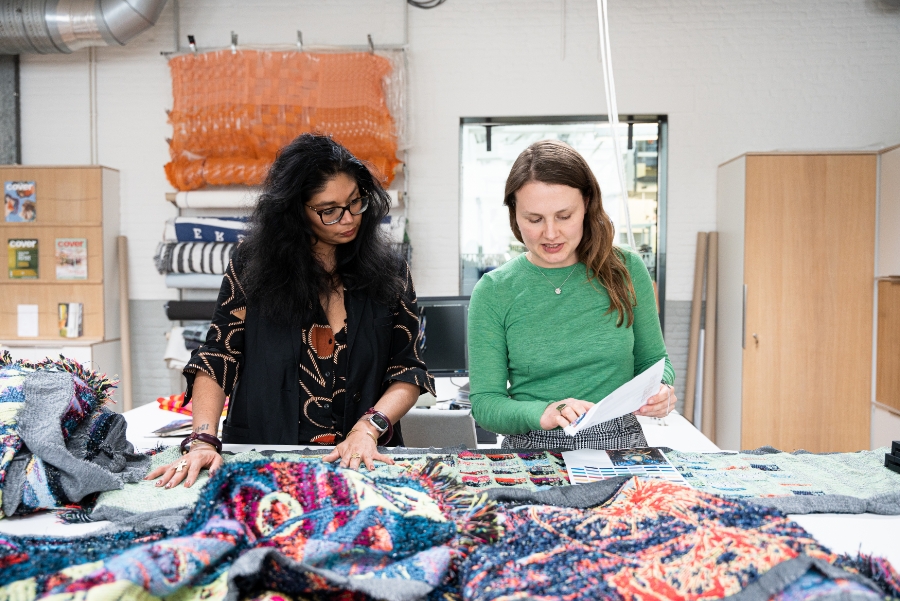Fascinated by Raquel van Haver’s sculptural art, the TextielMuseum asked her to weave two tapestries for the permanent collection. Van Haver found inspiration in Colombia’s Wayuu community, who taught her their secret weaving techniques. In the TextielLab, the team faced the challenge of converting these manual techniques into works of art suitable for the mechanical looms.
The exhibition Textile now – every thread tells a story has been on display in the TextielMuseum since mid-June. The exhibition includes new work by various artists who address social themes such as sexual and cultural diversity, climate change and the legacy of colonialism. Some of the featured makers had never worked with textiles before – like Raquel van Haver, who is known for her sculptural paintings and installations. The museum asked this successful young Amsterdam artist to create a textile work that had a link with her impressive sculptural pieces. Van Haver went to Guajira in Colombia, where her roots lie, and learned weaving and plaiting techniques from a Wayuu master weaver. “Women support the Wayuu community through weaving,” Van Haver says. “For generations, they have maintained a connection with their ancestors through their textiles, thus strengthening the bloodline.” The women use a special technique which is not written down anywhere but which they agreed to show Van Haver. She was inspired by their symbols and stories to design two tapestries.

Raquel van Haver with her tapestries. Photo: Patty van den Elshout / Detail of Van Haver’s tapestry. Photo: Josefina Eikenaar
Hammocks
Hammocks represent a sort of extension of the uterus for the Wayuu. Van Haver returned to the Netherlands with two traditional hammocks made specially for her and a bag full of other woven materials. In the TextielLab, the gap between hand-made and machine-made work soon became apparent. “I couldn’t even recreate many of the woven examples Raquel brought from Colombia on the machine because they used a completely different weaving technique,” says product developer Lotte van Dijk, indicating the diagonal weaving lines in the hand-made hammocks. Translating the designs from analogue to digital was also a challenge for Van Haver. “I never use a computer to make art. In the lab, you first have to digitise something you’ve drawn and painted by hand so it can be woven as a tangible cloth.” Moreover, her design sketches turned out to be too full and detailed for the sculptural effect that she and the curator wanted to achieve. “To get real depth, you have to create large areas with enough space for the filling yarns. The numerous colour changes in the sketches interfered with the 3D effect we wanted,” says Van Dijk.
Spiders
So, how do you capture the maker’s distinct style in a way that is technically feasible? The solution was to incorporate as many symbols, stories and structures as possible, the result of which is now seen in ‘Textile now – each thread tells a story’. ‘Anayawachijaa Kai’ (thank you sun) and ‘Anayawachijaa Kashi’ (thank you moon) are currently on display along with the hand-woven hammocks from Colombia. Just as Van Haver reinterprets traditional art in her paintings, in this new work she questions classical tapestry. She has combined geometric Wayuu patterns with her own figurative translation of animals and plants from the Wayuu’s myths and surroundings. The image’s different layers have been preserved, and there is a lot to see: one tapestry shows a large owl surveying a scene of birds, bats and sea creatures, with the master weaver’s round stamp in the background. The other tapestry is dominated by scurrying spiders and insects, with an imposing cactus as the focal point.

Raquel van Haver and product developer Lotte van Dijk. Photo: Patty van den Elshout
Painter’s eye
During the development process, new insights emerged about how best to do justice to the visual stories. Van Dijk says, “I noticed that Raquel looked at things with a painter’s eye. For example, an important change we made was to add yellow contour lines around the figures to make them stand out more.” Van Haver adds, “Drawing and painting are my first language. But I work with a range of techniques, and each technique requires something completely different.” On the eighth day of development, they made another adjustment to the composition – a small intervention for a painter but not for a weaver. “That was quite stressful because we only had ten days in total,” says Van Dijk. However, this meant that the second tapestry could then be produced in a day and a half. Van Haver finds this speed fascinating. “It takes me a month and a half to finish a painting, but a tapestry like this can be completed in five hours once the details have been properly programmed in the computer. And the result is fantastic. This is just the beginning. I feel like I still only know one percent of what there is to know, and I’m ready for more. Next time I’d like to spend a little longer making the design even more extreme and sculptural.”